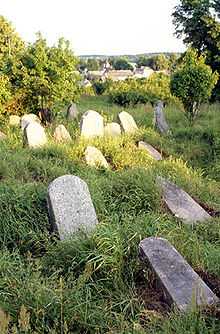Krynki
| Krynki | ||
|---|---|---|
| Town | ||
|
Saint Anne Church | ||
| ||
 Krynki | ||
| Coordinates: 53°15′56″N 23°46′20″E / 53.26556°N 23.77222°E | ||
| Country |
| |
| Voivodeship | Podlaskie | |
| County | Sokółka | |
| Gmina | Krynki | |
| Population | 2,709 | |
Krynki [ˈkrɨŋki] (Belarusian: Крынкі Krynki) is a town in northeastern Poland, located close to the Belarusian border in Podlaskie Voivodeship. Krynki is famous for its history and its old buildings. It lies approximately 24 kilometres (15 mi) south-east of Sokółka and 45 km (28 mi) east of the regional capital Białystok.
History
Krynki gained its town rights in 1569. It lost them in 1950 but it regained them in 2009.[1]
Krynki used to be a multicultural town. Up until 1914, the Jewish population was 9,000 people or about 90% of the town's population. The remainder was made up of Poles, Belarusians, and others. Today, the majority of Krynki's citizens are Poles, and there is a Belarusian minority.

Jewish heritage in Krynki
Jews started living in Krynki in the 17th century when Polish king Wladyslaw IV invited them to the town to develop trade and manufacturing. From that moment, the Jewish population continued growing and their culture flourished.
Chasidic Synagogue in Krynki
A notable part of Krynki's history was the Jewish labour movement of 1905. In that year, Jakow Pat led Jewish workers and created the independent Republic of Krynki. After World War I, the Jews began emigrating to Palestine and the United States. During World War II, in 1941, Germans executed 30 Jews, created a ghetto, and sent a large part of the Jewish population to the Treblinka extermination camp.
The Jewish population, however, did not remain passive — during an uprising in the ghetto, they killed 12 German policemen, and many Jews escaped. Today, no Jews live in Krynki, but the memory of them still lives on.
Points of interest
- One of the largest, oldest Jewish cemeteries in eastern Poland.
- Two Orthodox churches and cemeteries.
- St. Anne's Catholic church, designed by Stefan Szyller who is famous for designing the Poniatowski Bridge in Warsaw.
- Krynki originally was home to three synagogues. Two are still standing, however one was turned into a cinema, and the other is in ruins. The third, the largest, was burnt down in 1971 by the communist authorities.
Famous residents
Krynki is home to Sokrat Janowicz, the Polish-Belarusian poet, activist, and journalist.
References
| Wikimedia Commons has media related to Krynki, Podlaskie Voivodeship. |

